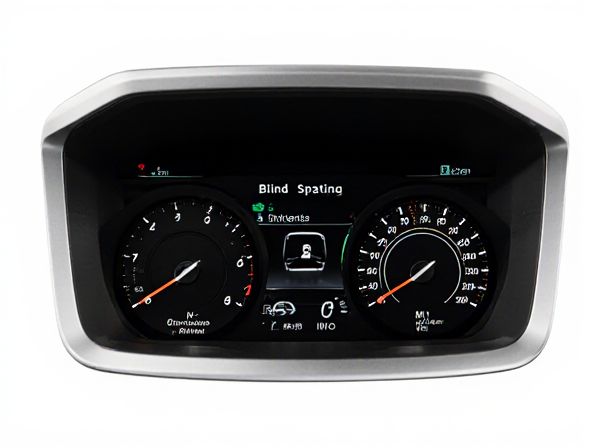
Photo illustration: Lane Departure Warning vs Blind Spot Monitor Indicator
Lane Departure Warning alerts you when your vehicle unintentionally drifts out of its lane, helping to prevent collisions caused by driver inattention or drowsiness. Blind Spot Monitor Indicator, on the other hand, detects vehicles in your blind spots during lane changes and provides visual or audible warnings to enhance safety. Both systems work together to increase awareness and reduce the risk of accidents on the road.
Table of Comparison
| Feature | Lane Departure Warning (LDW) | Blind Spot Monitor Indicator (BSM) |
|---|---|---|
| Purpose | Alerts driver when vehicle drifts out of lane unintentionally | Alerts driver of vehicles in adjacent blind spots |
| Detection Area | Lane markers on road sides | Side and rear blind spots |
| Alert Type | Audible, visual, or haptic warnings on dashboard | Visual indicator lights on side mirrors or dashboard |
| Sensor Technology | Camera-based lane detection systems | Radar sensors or ultrasonic sensors |
| Primary Benefit | Prevents accidental lane drifting, reducing collision risks | Improves safe lane changes by indicating hidden vehicles |
| Common Dashboard Indicator | Lane icon with vehicle drifting symbol | Side mirror light or dashboard icon with car and blind spot symbol |
Introduction to Lane Departure Warning and Blind Spot Monitor
Lane Departure Warning (LDW) systems use cameras and sensors to detect unintentional vehicle drift from its lane, alerting drivers with visual, audible, or haptic signals to enhance road safety. Blind Spot Monitor (BSM) indicators employ radar or ultrasonic sensors to identify vehicles in adjacent lanes' blind spots, providing warnings through side mirror lights or dashboard alerts. Both technologies serve as crucial driver assistance features, reducing collision risks by improving situational awareness during lane changes and highway driving.
How Lane Departure Warning Systems Work
Lane Departure Warning systems utilize cameras or sensors to monitor road markings and detect unintentional lane drifting by the vehicle. When the system identifies that the car is moving out of its lane without signaling, it alerts the driver through audible, visual, or haptic warnings, aiming to prevent accidents caused by inattentiveness or drowsiness. These systems rely on algorithms analyzing lane curvature and vehicle position to provide real-time feedback and enhance road safety.
Functionality of Blind Spot Monitor Indicators
Blind Spot Monitor Indicators use radar or cameras to detect vehicles in adjacent lanes that may not be visible in the driver's side or rearview mirrors, alerting the driver to potential hazards during lane changes. This system enhances safety by providing visual or auditory warnings when another vehicle enters the blind spot, reducing the risk of collisions. Unlike Lane Departure Warning, which focuses on lane markings to prevent unintentional drifting, Blind Spot Monitors specifically track lateral vehicle positions to assist with safe lane changes.
Key Differences Between the Two Systems
Lane Departure Warning (LDW) detects unintentional lane drifting using cameras and sensors to alert drivers when the vehicle crosses lane markings without signaling. Blind Spot Monitor (BSM) uses radar or ultrasonic sensors to detect vehicles in adjacent lanes' blind spots and provides visual or auditory warnings to prevent collisions during lane changes. While LDW focuses on maintaining lane position, BSM prioritizes awareness of surrounding vehicles in hard-to-see areas, enhancing overall driving safety.
Benefits of Lane Departure Warning
Lane Departure Warning enhances driving safety by alerting drivers when their vehicle unintentionally drifts out of its lane, reducing the risk of accidents caused by distracted or drowsy driving. This system provides timely visual, auditory, or haptic warnings, helping maintain lane discipline and preventing potential collisions. Compared to Blind Spot Monitor Indicators, Lane Departure Warning actively supports lane-keeping, offering proactive protection on highways and busy roads.
Advantages of Blind Spot Monitoring
Blind Spot Monitoring (BSM) enhances driver safety by continuously detecting vehicles in adjacent lanes, reducing the risk of collisions during lane changes. Unlike Lane Departure Warning systems that alert only when drifting out of lanes, BSM provides proactive alerts about hidden vehicles in blind spots, improving situational awareness. This system's real-time visual or auditory indicators help prevent side-swipe accidents, especially in heavy traffic or poor visibility conditions.
Limitations and Potential Drawbacks
Lane Departure Warning systems often struggle with unclear or faded lane markings, reducing their effectiveness in poor weather or road conditions. Blind Spot Monitor Indicators can produce false alerts in heavy traffic or fail to detect small, fast-moving objects like motorcycles. Both systems may cause driver overreliance, leading to diminished attention and delayed reaction times in critical situations.
Safety Impact and Real-World Effectiveness
Lane Departure Warning systems enhance safety by alerting drivers when the vehicle unintentionally drifts from its lane, reducing collision risks caused by driver inattention or drowsiness. Blind Spot Monitor Indicators improve situational awareness by detecting vehicles in adjacent lanes, preventing side-swipe accidents during lane changes. Both technologies significantly decrease accident rates, with real-world studies showing lane departure warnings reduce single-vehicle crashes by up to 11% and blind spot monitors lower lane-change collisions by approximately 14%.
Lane Departure Warning vs Blind Spot Monitor: Which is Better?
Lane Departure Warning (LDW) and Blind Spot Monitor (BSM) serve distinct safety functions: LDW alerts drivers when they unintentionally drift out of their lane, while BSM detects vehicles in adjacent lanes that may be invisible in mirrors. LDW is better for preventing runway road drift and head-on collisions, whereas BSM excels in avoiding side-swipe accidents during lane changes. Selecting between LDW and BSM depends on driving habits and environment, but combining both systems offers comprehensive protection against lane-related hazards.
Future Trends in Vehicle Safety Technologies
Lane Departure Warning systems and Blind Spot Monitor Indicators are evolving with advanced sensor fusion and AI algorithms to provide more accurate real-time alerts. Future trends include integration with autonomous driving frameworks, enhanced vehicle-to-vehicle communication, and predictive analytics to prevent accidents before they occur. These technologies aim to create a comprehensive safety net, improving situational awareness and reducing human error on the road.
 caratoz.com
caratoz.com